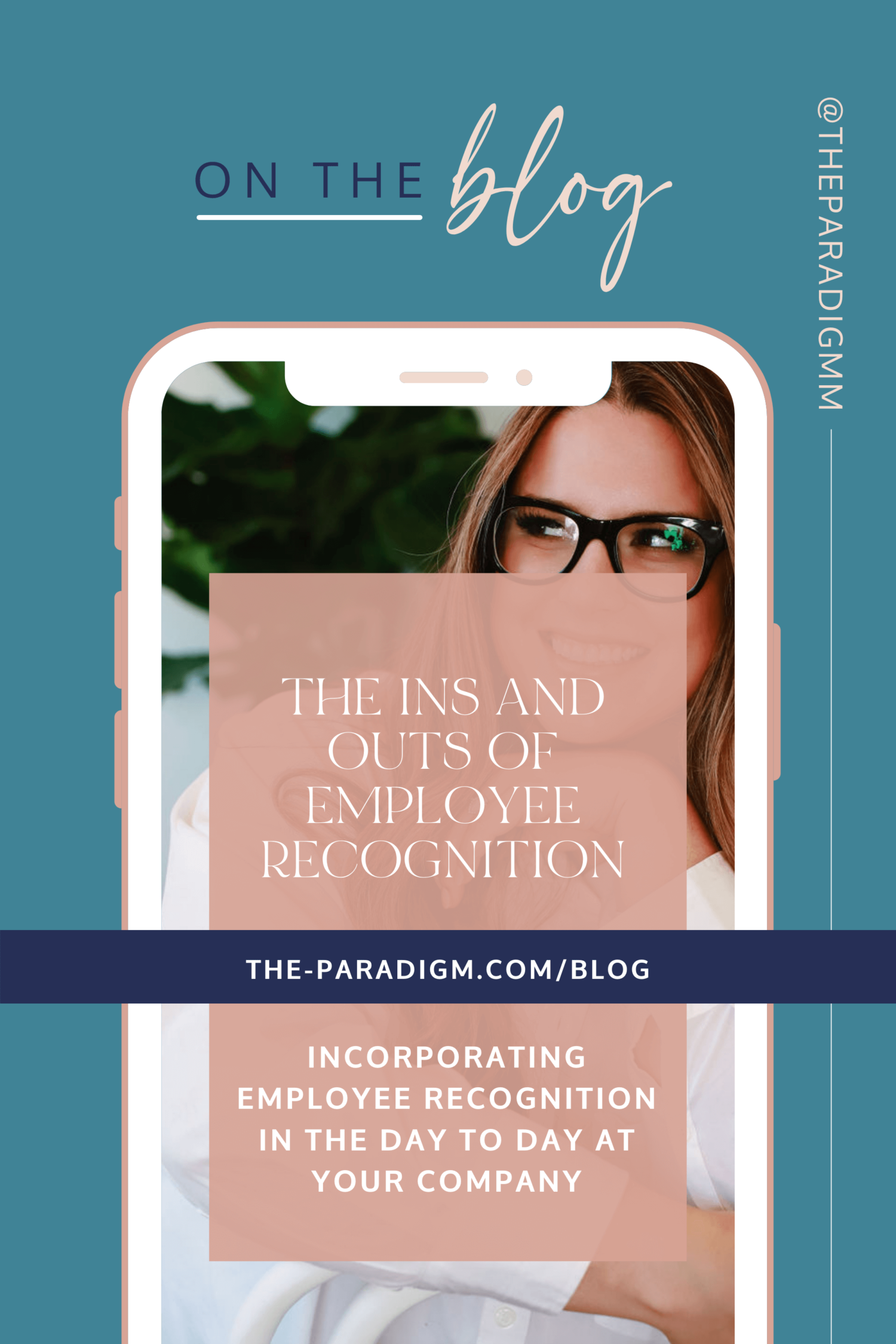May 3, 2022
Kira La Forgia, CEO & Founder | Paradigm Consulting
One of my favorite things about working in management consulting is the personal elements that come from setting up an amazing employee experience. In many ways, the employee experience is driven from start to finish by HR, with the HR policies running in the background of an impactful management strategy. Beginning the discussion of employee recognition is not about gift cards or kudos, it’s inherently about gratitude, and creating an uplifiting culture where it is not only safe, but encouraged, to express gratitude to your team.
The most unique thing that happens when we talk about employee recognition in the workplace is the immediate (and often “written all over their face”) response to the topic amongst team members, managers, and CEOs.
Here’s how this narrative often plays out:
HR announces the roll-out of an Employee Recognition program.
Employee: FINALLY! That’s awesome, I can’t wait to be recognized!
Manager: How the heck am I going to fit this in my busy schedule? They know I appreciate them! We have a meme channel on slack and I always approve their time off!
CEO: Interesting, the managers better do a good job!
It’s not hard to see the tension between these initial reactions.
Let’s break down these mindsets.
First, let’s talk about the employee’s thoughts. Many employees and team members often feel like they are not fully appreciated for the work they do, even when they have the best managers. When HR or a team leader tells them that there will be an initiative to intentionally and thoughtfully recognize the work they do, they are often like “I hope this gets me a chance to be seen and noticed” and also “maybe I’ll get a gift card or something”… in that order.
On that note, the manager is thinking about this in a purely transactional way. While it’s true that they likely will have more tasks added to their to-do list in order to ensure their team has a higher level of recognition, they may not realize that this is about making THEIR lives easier in the process. Having an engaged team is tied directly to having a recognized team. And an engaged team has lower turnover, higher productivity, better attitude, and generally is more fun to manage.
The CEO knows the theory behind the ROI of employee recognition, so when they take the trouble to roll out an initiative, they are excited and motivated and ready to add value everywhere they can. I mean obviously! Recognizing an employee is a fraction of the cost of replacing the employee. With recruiter fees at an average of 30% of the annual salary for high performing individuals, and the average in house HR generalist’s salaries averaging at almost $60,000 per year for an entry level position, backfilling a role is not in the organization’s best interests.
Cultural Implications
In small business environments, there are so many opportunities on the day to day basis to recognize an employee’s work. If you’re able to,
Time is of the essence.
The least amount of time between a commendable action and the recognition is the gold standard. Not only does this show you are paying attention to what is happening in the day to day grind of your company, but it also encourages behaviors. It’s as simple as the positive reinforcement we have been learning about our whole life. When you see something extraordinary, point it out, show true gratitude and emotion. This will likely give your team member a little burst of dopamine, making them feel good, and associate their actions with that result, creating a desire to keep doing exceptional work worth of that recognition. It’s science!
Be authentic.
Don’t recognize just to recognize. If your managers are forced to hit a certain “quota” of recognition, then the work will be meaningless. For peers, we want to encourage a safe space for people to recognize each other and to speak up when there are opportunities, but we have to lead with authenticity first.
Leverage your relationship.
We often hear “praise in public, criticize in private” and we couldn’t agree more. However, I have worked with team members who would prefer to not have their work praised in a public setting. In fact, I have a team member who explicitly asked their manager NOT to put them on the spot at meetings as it causes severe emotional distress and anxiety. They chose to work in a remote space as they are incredibly shy. So while the common practice within the organization might be to do weekly shout-outs or recognition during the weekly team meeting, this employee had come to dread those moments, hoping they wouldn’t be recognized. Effectively harming their relationship with the company. Getting to know your team members and putting what makes THEM feel appreciated is key.
Be specific.
Instead of “great job today” try outlining a specific and impactful way that your team member made a difference in the project.
Try using this formula: Name, gratitude, specific outstanding task, why it mattered.
Example: “Kiley, thank you so much for your help building the onboarding site for our client! That really made their new hire experience unique and special.”
Multiple Avenues of Recognition
If you are to create an environment where recognition is commonplace, you MUST establish multiple avenues where team members can recognize each other. For remote teams, there is an abundance of employee recognition software that can be utilized through systems you already have in place.
If every single weekly meeting, everyone goes around and “shouts out” another team member for something, the practice will end up meaningless and the recognition will lose its luster. The thing that most companies struggle with in employee recognition is that it can’t be systematized. Teaching yourself, your managers and your team to recognize each other’s success as a part of your day to day communication is KEY in building a truly effective culture of recognition.
Try a Tiered Approach To Employee Recognition
Daily
Something quick and easy for the daily options, like a Slack add-on like Bonusly or Hey Taco.
Weekly
Digital check ins via a 15 minute coffee call that recur weekly. Make sure to touch on the positive throughout the week and encourage your team to find ways to highlight other employees. When you discuss the positives, never follow up with a BUT. Leading with a positive to give constructive feedback or criticism can steal the wind from the sails and lose the positivity of the entire thing immediately.
Monthly
This is where the gifts, physical awards, and budgets come into play. Allowing your managers a budget each month (or yourself) to send lunch, gift cards, a unique gift, or even a small boxfox to recognize an exceptional act is a high value reward and can reach your remote team in a more tangible way. Let’s say each manager gets $100 a month, and you have 3 managers on your team with direct reports. This $300 expense toward employee recognition is a fraction of what it costs to backfill a position.
The Impact of Gratitude
Have you ever heard the saying “sh*t rolls downhill”? It’s a) disgusting and b) true. As you get closer and closer to the top of the org chart, there is undoubtedly more pressure to fulfill the job duties. If you don’t know what I’m talking about, check out this clip from How I Met Your Mother explaining the “Chain of Screaming” as only Neil Patrick Harris can.
So the same thing works with gratitude. The more you show gratitude in an authentic way, the more your team will feed that energy down through your organization. If you want to get started with employee recognition in the workplace, we suggest starting a gratitude roundtable at your weekly meeting. This is a great way to engage your employees, find out more about what they value, and open up another avenue of peer recognition.
Summary
It’s no surprise that Employee Recognition is an effective tool in building an intentional culture in your company. If you want to make the highest impact in an employee recognition program, we suggest starting with learning about your team, prioritizing recognition, and create a recognition system within your company that allows for multiple avenues.

